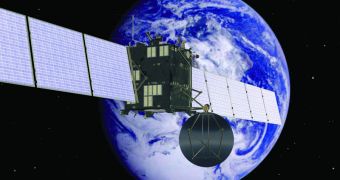Last weekend, the Minor Planet Center announced they detected a Near Earth Object that would miss the Earth only by 5,600 kilometers. The newly discovered object, has been given an official name by the MPC, run by Smithsonian Astrophysical Observatory. 2007 VN84 was tracked by a number of astronomers around the world to determine the threat this object poses.
It would be the closest approach of a sizable asteroid, located at a distance only half the diameter of the Earth. But after further inspection, Denis Denisenko, from Moscow's Space Research Institute, found that the asteroid matched exactly the trajectory of the European's Space Agency, spacecraft Rosetta, programmed for a fly-by of Earth.
The spacecraft Rosetta was launched in March 2004 by the European Space Agency, to get in the close orbit of the comet Churyumov-Gerasimenko, with which it will meet in 2014 at a distance of 675 million kilometers from the Sun, and escort it in its path around it until December 2015. Rosetta, will also deliver a lander Philae, which will touch down on the comet's surface. To get to the rendezvous point, Rosetta has to make a series of fly-by's or swings around the inner planets to gather speed with the help of the powerful gravitational fields, and also to operate eventual corrections to the trajectory.
The gravity assisted technique consists of three swings around the Earth and one around Mars. This is the second programmed fly-by around Earth, and the last will take place in November 2009, after which Rosetta will explore asteroid 21 Lutetia, and fall into a deep space hibernation, until 2014 when it will approach the comet.
The discovery made by Denisenko came at the right time, the Britain's Royal Astronomy Society was already preparing a press statement to announce on Monday the discovery of the Near Earth Object. Also, the designated name for the minor planet 2007 VN84, has been withdrawn by MPC.
The embarrassing incident shows the deplorable state of availability of positional information, of the distant artificial objects currently present in space, such as satellites and spacecrafts in Earth's orbit and in the solar orbit. The authority that supervises these objects, the Distant Artificial Satellites Observations, lists a number of such objects, and has to be updated on a regular basis from five different sources, but data is not always available at the right time, so a single source of information would be needed to better improve its performance.

 14 DAY TRIAL //
14 DAY TRIAL //